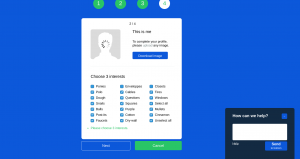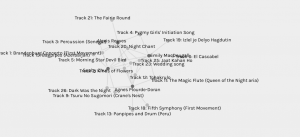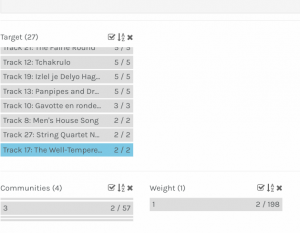Connection #1 – Amanda (Task 1)
Link: https://blogs.ubc.ca/webspace/2022/05/29/whats-in-my-bag-2/
How has your colleague’s experience differed from yours? And how do you know?
| Amanda |
Me |
Similar or Different? |
| “help me function through my daily routines” |
“essentials I regularly ensure that are in my purse before leaving the house” |
Similar. We both discuss that the items in our bags are purposeful and necessary for our daily routines. |
| “I stay connected throughout the day” |
“My career as a teacher relies on an exceptional amount of planning, prepping and communicating outside the school day” |
Similar. We both feel the pressure to remain in touch, communication-wise with our school community as a teacher. |
| “My bag today looks very different than what it would have looked like 15 years ago.” |
“If I were to take a look at my bag 10 years ago…” |
Similar. We both described how different our bags would be 10-15 years ago, and identified particular items that would be different. |
What web authoring tool have they chosen to manifest their work?
Amanda used an iPhone to take a picture of her bag contents and uploaded it to her WordPress site.
How does their tool differ from yours in the ways in which it allows content-authoring and end-user interface?
Amanda’s website has a section that highlights recent comments on her posts, which is optimal to view our classmate’s interactions with her content. I also have this feature on my site. I actually noticed that I was not receiving comments after the second week. I quickly realized it was because I had published my tasks as pages, which do not offer options for comments. I redesigned the items within the menus on my site and reposted the pages into posts, which are now open for comments.
What literacies does their site privilege or deny in comparison and contrast to yours?
Amanda described more in-depth a few items of interest, the guitar pick, blue token and air tag. Her reflection on traditions, suggests that cultural literacy proves to be a focus within her writing. She describes that the guitar pick is regularly in her backpack which speaks to the musicality in her life, and her talent for playing the guitar. I wonder where Amanda learned how to play guitar, and what experiences led her to continue her passion for playing, as she describes having guitar picks throughout the places she frequents. She also identifies that she has blue tokens as a reward for student behaviour. We know from Behaviourism theory, that using tokens to reinforce behaviour aligns with the token economy system in behaviour modification. Lastly, the apple air tag is a new trend in tracking the location of items, or friends/family. This would increase efficiency in locating critical items such as keys, or a backpack. Also, it highlights the current context, in that society needs a ‘stuff locator’ because we all have so much stuff.
I also speak about traditions in my task submission, when I describe my motivation for volunteering and compare how my dad carried memories with him as photographs. I reference Alexander Macdonald (2016) in my post demonstrating how traditions can be reinvented and reused over time, and this is relevant when examining the contents in our bag. When comparing what we have in our bags, people in the future will compare items that have in common/different, just as we compare to people in the past when trying to examine the context. Oral tradition was focused on by Macdonald (2016) and I wonder if teachers that taught Amanda, or teachers at her school taught her to use the blue tokens with one of her students, or if she observed this being done as a classmate.
References
TEDxTalks. (2016, February 26). Oral tradition in the age of smartphones | Alexander Macdonald | Tedxfulbrightdublin [Video]. YouTube. https://www.youtube.com/watch?v=egO_46P894k
Connection #2 – Trista (Task 6)
Link: https://blogs.ubc.ca/etec540trista/2022/06/25/task-6-a-emoji-story/
How has your colleague’s experience differed from yours? And how do you know?
| Trista |
Me |
Similar/Different |
| “almost felt impossible to find a picture for some words that are general and vague” |
“For instance, with the word create, I tried to find another word that would connect to an emoji, but was unable to do so.” |
Similar. We both felt as though it was difficult searching for an emoji image to represent words to project our meaning to the audience. |
| “As an educator, it makes me question whether my literacy teaching practice is preparing my students for this multimodal representation that they will face in the future.” |
No contribution on this subject. |
Different. After Trista reflected on her process she questioned if as teachers are we preparing students for the multi-modal world of representation. Not only to respond/view/read but also to create? This is a valuable reflection item. |
| “Depiction of pictures largely depends on the viewer” |
“I considered my audience” |
Similar. We both considered the audience of our published works. This was interesting, as sometimes when I write I often just think about my own clarity of the text I write. However, I was hyper-focused on this task to ensure that the audience would be able to make meaning of what I wrote. |
What web authoring tool have they chosen to manifest their work? How does their tool differ from yours in the ways in which it allows content-authoring and end-user interface?
Trista used WordPress, and what I liked about her site is that it is bright white and simple. My site is a themed template, and is colourful and may look vibrant, but may be too visually stimulating or busy for some users. The text font is easy to read, and it is simple to navigate, as you can progress to the last or next post at the bottom. I do not offer that feature, but instead, have a menu on the left-hand side for users to navigate. Also, she has comments enabled, allowing for an interactive interface.
What literacies does their site privilege or deny in comparison and contrast to yours?
Trista highlights her experiences in writing influencing this emoji activity. We are used to writing events in chronological order, especially when recalling events, or summarizing something we viewed, listened to or read. She identifies that she naturally wrote her story in chronological order. That intrigued me because when using text, we naturally expect when hearing or reading or listening to a summary that the recall will state the order of events, interactions with characters, or influential moments. This is the general understanding amongst our literacy teachings and understandings. When creating multimodal, do we have the same expectations to understand things in order, or are there different rules or understanding in multimodal representations?
My post focused on how it was difficult to select emojis that conveyed the explicit meaning of the words I used in my summarising paragraph. I described that it was difficult to convert every word into an emoji and instead the emoji had to be symbolic of an event or idea. Most of the emojis represented proper nouns, and it was hard to find verbs, let alone adjectives to create simple sentences with emojis.
The similarity between our posts is that we engaged with the idea that the rules for text communication are ingrained in us, and it is hard to be confident with how we communicate without experience or a set of rules to follow.
Connection #3 – Alexis (Task 7)
Link: https://blogs.ubc.ca/communicationjunction/
How has your colleague’s experience differed from yours? And how do you know?
| Alexis |
Me |
Similar/Different? |
| “Completely embrace multiliteracy” |
“Redesigned the activity” |
Similar in that we both exhibited creativity, however, Alexis utilized multimodal pathways to re-express her Task 1 posting. I redesigned the activity focusing on sound and audio |
| “allow for those that learn better in a more kinaesthetic way” |
“The sounds that you choose may lead to more insight than we may be aware of. “ |
Different. Whereas I created/redesigned an activity for classmates to do that asked the audience to tell us more about themselves, Alexis diversified all her content to reach an extended audience immediately. Alexis did a great job at ensuring she was inclusive in her post. |
| “I therefore included opportunies in the remixed content to comment, contribute and co-author and ‘like’ comments or material that the audience could relate to or saw as relevant to them.” |
“Did you feel an urge to want to shut it off?” and “Classmates, I would love to hear about your preferred sound notifications!” |
Similar. Both of our postings included encouragement of our audience to interact with our posts. For Alexis, they could comment and contribute, and for me, I was deliberate in creating a prompting question for my audience. |
What web authoring tool have they chosen to manifest their work?
Alexis had an entry that captivated my interest, in their choice to use a multimodal presentation of their work, with the platform ‘milanote’.I have never seen or heard of this platform before, so I took some time throughout the week to explore it. Milanote (https://milanote.com/) is a visual board that embeds, notes, videos, links, drawings, images etc. in a digital board, akin to an interactive bulletin board. The platform is collaborative. I appreciate that they used this collaborative board, especially since this week we focused on multi-modal representations and this is a significant example of a multimodal representation. Precisely including the elements of the assignment, audio and images, and interactive. She included a link in which we can use to go directly to the site, and en embed an image that I was not able to view due to my computer settings, but I can tell is there.
How does their tool differ from yours in the ways in which it allows content-authoring and end-user interface? What literacies does their site privilege or deny in comparison and contrast to yours?
One of the modes Alexis used to convey their meaning, is ‘Mimix’ (https://apps.apple.com/us/app/mimix-sign-language-translator/id1156035569) a sign language translator app, that uses a 3D avatar to communicate in ASL. This is so incredible, I have never come across this before. I wish for my project that I considered inclusion because although I did create a transcript for my audio, including a sign language translation offers an extension in inclusion to those who utilize ASL to communicate. My post was not as interactive as Alexis’. Mine was creative in that I maintained the same goal of the task, which was to get to know my classmates, but I chose another way in which my classmates could share more about them. This engagement is telling more about you by taking a look at your habits, or personal settings/belongings is more interesting than just writing an introduction summary on oneself stating generic statements about your life. I was creative in my idea of how to redesign the mode of the task I believe. I also think Alexis exhibited substantial creativity in this weekly task.
Connection #4 – Sophy (Task 10)
Link- https://blogs.ubc.ca/etec540thc/2022/07/23/task-10-attention-economy/
How has your colleague’s experience differed from yours? And how do you know?
One of the most evident differences in Task 10, the Attention Economy task, is that Sophy was able to make it to the end. We both acknowledged our frustrations with the task, but they were able to complete the task in a decent amount of time! Impressive! The screenshots that are included on their webpage are frames of the congratulatory message reaching the end, acknowledging the success they had in the game. I was so surprised to see their observation of the Cyrillic character that was optional in the password. I did not observe that small specific aspect.
A similarity in both our task reflections was the expectation that we have for any experience interacting with webpages, we have this unconscious expectation it will be familiar with what we have come to experience before.
How does their tool differ from yours in the ways in which it allows content-authoring and end-user interface?
I see they included a Genially slideshow of images, and I have not tried that yet in my postings. If the situation permits, I hope to try it in the future. Inserting those slides makes the post more dynamic.
What theoretical underpinnings are evident in your/your colleague’s textual architecture and how does this affect one’s experience of the work?
Harris (2017) states that technology is not neutral, and then in week 12, listening to episode 60 of Leading Lines from Vanderbilt University, one of the speakers also put forward, that technology is neither good nor bad, but it is not neutral either. I found this theme present this week, as Harris (2017) describes the “race for our attention”. This game certainly shows that technology can be deceiving, but favours those who pay close attention, therefore not neutral.
When I was listening to Tufekci (2017), it was intriguing when she explored how we would have no idea if people were being shown the same information when it comes to sites that host algorithms. Also, the speaker mentions that at some point, there are algorithms that can only be understood at a basic level. What I started to imagine, is it would be to our benefit, if instead of, or in addition to the ‘privacy’ button that resides on most websites also had a link to a video, in basic language explaining how data is being collected, storage information of it, and if it is contributing to an algorithm, or if you are being shown limited content. In Task 10, I certainly had difficulty, and wondered too, is my game experience different than someone else’s? We would assume it is the same, but what if it is randomized to truly infuriate 1/10 people, with having no solutions for moving forward, and that person was me? It is unlikely, but it connects with Tufekci’s (2017) point on how we know if the information is being withheld from us, or if we are provided with a different experience in online services because of algorithm bias.
In our Task 10, I was hesitant early on, because it requested our email address, and nowhere on the site did it describe why they needed our email address, and what would be done with it. Whereas, Sophy clearly went past this page, and was able to decide to provide this information in a quick manner, due to the time at end of 6:23. This is a current dark pattern that is so prevalent today. Privacy buttons are accessible, however, they are often at the very bottom of a website home page, and include jargon that is not comprehensible to the average person. There is still not enough specific information that is being shared. Tufekci (2017), also states, “imagine what a state can do with the immense amount of data”. The speaker goes on to explain how politicians and people of technological and financial power can manipulate and persuade us, without us knowing it. A solution for this would be increasing education of the general population- with my idea of increasing education on algorithms, data, and technology, with providing clear and simple videos for people that describe exactly what the goals of the site are ie. data collection, where they are selling it to, algorithms etc.
References
Harris, T. (2017). How a handful of tech companies control billions of minds every day. [Video]. TEDx. https://www.ted.com/talks/tristan_harris_the_manipulative_tricks_tech_companies_use_to_capture_your_attention?language=en
Tufekci, Z. (2017). We’re building a dystopia just to make people click on ads. [Video]. TEDx. https://www.ted.com/talks/zeynep_tufekci_we_re_building_a_dystopia_just_to_make_people_click_on_ads?language=en
Connection #5– Liana (Task 8)
Link: https://blogs.ubc.ca/540ranallo/2022/07/17/golden-record-curation/
How has your colleague’s experience differed from yours? And how do you know?
Liana identified three main foci of how they would come to a decision for the song list, which included: country, emotional response, and musical instruments. I thought this was a unique approach to maintaining three distinct criteria when deciding on each song. Although I was not as specific as Liana in my overall motives, we did show similarities in our choices. I selected the song ‘Jaat Kahan Ho’, and identified that I wanted this part of the world to be included in the music. Here I considered that a multitude of geographical areas should be represented as Liana felt. Next, I selected ‘Peru, panpipes and drum’ based on the drum as a musical instrument. Liana listed instruments that were integral to include, however, I was intentional in varying some of the instruments to ensure at least one song was recognizable.
However, I did not choose a song based solely on its emotional response, although I was tempted to initially. I describe in my reflection how I wanted to choose which ones were my favourite, based solely on how I felt when listening, but I decided to ensure I had a reason for each. Liana identifies that “music is emotional rather than a logical experience”. For this assignment, I went entirely the logical route and solely considered how to connect our world features to the lifeforms accepting the music.
What web authoring tool have they chosen to manifest their work?
Liana used the WordPress site, and I liked the style and design of their website. It is easy to navigate, with hyperlinks to other tasks along the top, whereas mine can be found along the side.
Connection #6 – Thomas (Task 12)
Link: https://blogs.ubc.ca/thomasw/task-12-speculative-futures/
How has your colleague’s experience differed from yours? And how do you know?
In my assignment, I created a utopian and dystopian narrative in a video format, where the viewers were able to imagine what both worlds would be like. Thomas uniquely combined both worlds in a GIF which I thought was imaginative! I am also intrigued that his final project will be in a documentary format. I also thought it was unique in his description that he described that even the person in power was “plugged in” to someone else’s ideas, shaping their every move. Sometimes people who are in positions of power, are in fact powerless and are held hostage by others’ desires, and vision.
What web authoring tool have they chosen to manifest their work?
Thomas utilized photoshop to create a GIF to describe a speculative future. I am so impressed with how he created this! I have never attempted this before and would like to take time to dabble with it at some point. The GIF was simple but quite representative of how people in power can have an incredible impact on us, reminding me of our week 8 module. Also, the fact that the politician revealed themselves as a robot was quite awesome!
What theoretical underpinnings are evident in your colleague’s textual architecture and how does this affect one’s experience of the work?
Thomas references Dr. Shannon Vallor’s (2018) “Lessons from the AI Mirror”, and when she describes how people are often afraid of AI, he compares it to what people around him think. I often view in media and videos, or in conversations with friends what Thomas encounters. We both hear the fear in people’s voices, or uncertainty of the world is going to be taken over by robots.
I was quite reflective when listening to Vallor’s (2018) lecture after I heard that AI only accelerates problems we already have created as humans. Often we think that AI is this powerful force. People think that our devices are listening to us in our homes, placing power in inanimate objects. When the truth is- there are people behind gathering data and surveillance on us. The ego of the human and the desire for wealth is the driving force for wanting to know more about each person. Humans are able to protect other humans from harm or invasiveness from AI.
References
Santaclaraweb. (2018, November 6). Lessons from the ai mirror Shannon Vallor. [Video]. YouTube. https://www.youtube.com/watch?v=40UbpSoYN4k&feature=emb_imp_woyt
A handful of other interactions & comments:
June 12th, 2022
https://blogs.ubc.ca/jpresta/2022/05/25/whats-in-your-bag/
Jessica, it was so interesting to learn more about you! Something that resonated with me was when you mentioned that 10 years ago you would have had papers in your purse, and now there are no papers to be found. At the beginning of my teaching career, I had to manage and organize an exceptional amount of documents, while teaching 8th grade. Now, using Google Classroom, most student work is stored on that platform and is organized and accessible. It makes me curious about the changes ten years from now!
June 18th, 2022
https://blogs.ubc.ca/communicationjunction/2022/05/21/whats-in-your-bag/
Thanks for sharing some insight into who you are, through the contents of your bag! One thing I noted was how you mentioned that the headphones may receive some harsh criticism from archaeologists. That was so insightful, in that you are right, the technology for listening to music is going to be beyond what we can imagine moving into the future. For instance, I have included a link to a video that shows new technology for music, where the user does not need headphones, in fact, a sound bubble is created around the user. Check out the video here: https://www.youtube.com/watch?v=4zHxwUJR8dQ&feature=emb_logo. If we have this type of technology sometime in the future, headphones will one day become obsolete, and useless. This supports how you described the archaeologists as less than impressed with your headphones, or any headphones for that matter
June 18th, 2022
https://blogs.ubc.ca/katherineetec540/2022/06/11/task-4-manual-scripts/#comment-6
Katherine, your written manuscript is so wonderful. As a teacher myself, I have also come to realize how you mentioned, is important to keep our awareness of the influence and impact we have at the forefront of our minds, when coming in to work. How special it is when our students and their families recognize the care, dedication and compassion that we have by acknowledging us in some way. That is such a good feeling, and so motivating. I considered your testament while writing, that you wanted to erase some of your work, but because you were handwriting, you had to really think about the words, before you even wrote them down. This made me connect when selecting between texting or a phone call, I may choose texting/email if the conversation is difficult, or I really need to be mindful of the words I am using. I think the most vulnerable communication method is oral communication because you cannot take back what you say, as the person you are talking with processes what you say as soon as you release your words. The next would be hand-writing a card or a formal letter because again you have to commit to the words you choose or need to use white-out or throw out the paper entirely. Lastly would be text or email, because you can pace when you respond, and revise your work without the recipient being aware of your edits or mistakes in writing. Interesting how the pressure to be correct in our communication impacts our choice of media used when communicating with another person or group.
June 19th, 2022
https://blogs.ubc.ca/jpresta/2022/06/13/task-5-twine-task/
Your Twine was so well done and incredibly educational. The sound effects, visuals and text were exceptional!



